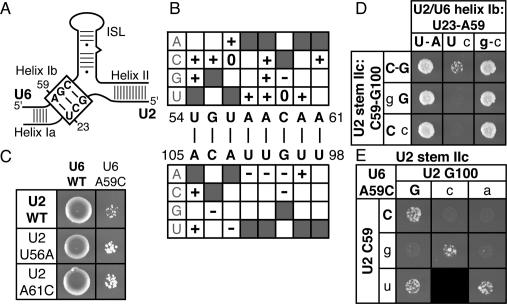Figure 6.
Disrupting U2 stem IIc exacerbates disruption of U2/U6 helix Ib, which includes the U6–AGC triad. (A) Schematic of U2/U6 base-pairing; U2/U6 helix Ib is boxed. (B–E) Mutations in the 5′ side of stem IIc largely suppress U6–A59C, while mutations in the 3′ side largely exacerbate. Genetic interactions between U2 stem IIc point or double mutations and U6 variants in strain XYU96 (Xu et al. 1998) are shown. (B) Summary of genetic interactions between U2 stem IIc point mutations and U6–A59C, a mutation in the AGC triad that disrupts U2/U6 helix Ib. Weak suppressors (+), enhancers (−), and those that do not interact (0) are indicated. Shaded boxes mark wild-type nucleotides; white boxes mark mutations that were not tested. Note: For all mutations tested, repair of stem IIc failed to abolish suppression (data not shown) but did abolish enhancement (see E; data not shown). (C) Representative mutations in loop IIa that weakly suppress the growth defect of U6–A59C. The identity of U2 is indicated to the right and the identity of U6 is indicated on top. Cells were grown for 6 d at 30°C on solid media containing 5-FOA. (D) Mutations in U2 stem IIc that exacerbate the growth defect of U6–A59C do so by enhancing disruption of U2/U6 helix Ib. The matrix shows the growth of cells expressing U2 variants that disrupt the U2 stem IIc base pair C59/G100 (rows) and U2 and/or U6 mutations that alter base-pairing in U2/U6 helix Ib (columns). Cells were grown for 5 d at 30°C on solid media containing 5-FOA. (E) Mutations in U2 stem IIc that exacerbate the growth defect of U6–A59C do so by disrupting stem IIc. A compensatory analysis by growth is shown for the U2 stem IIc base pair C59/G100. All strains expressed U6–A59C. Growth conditions were the same as in D.

